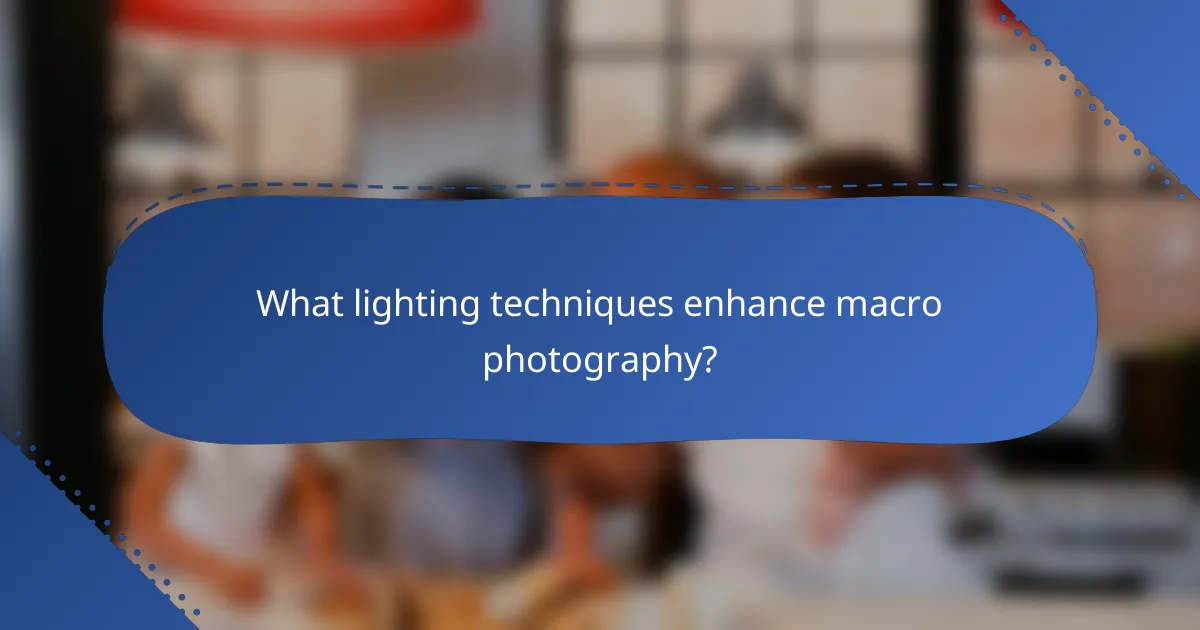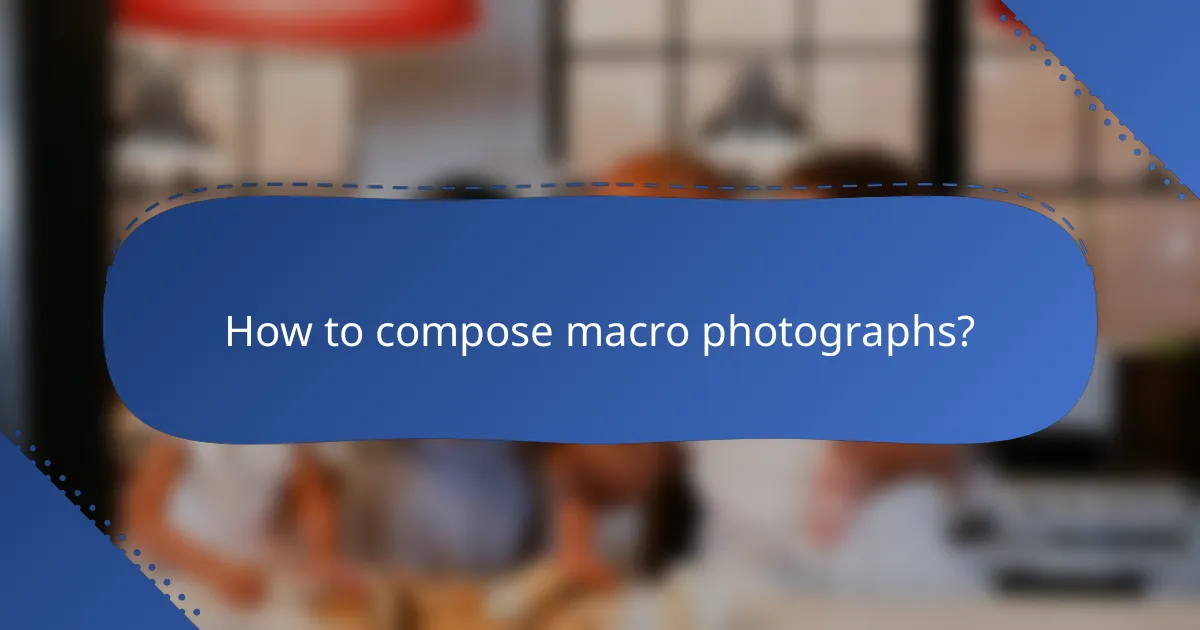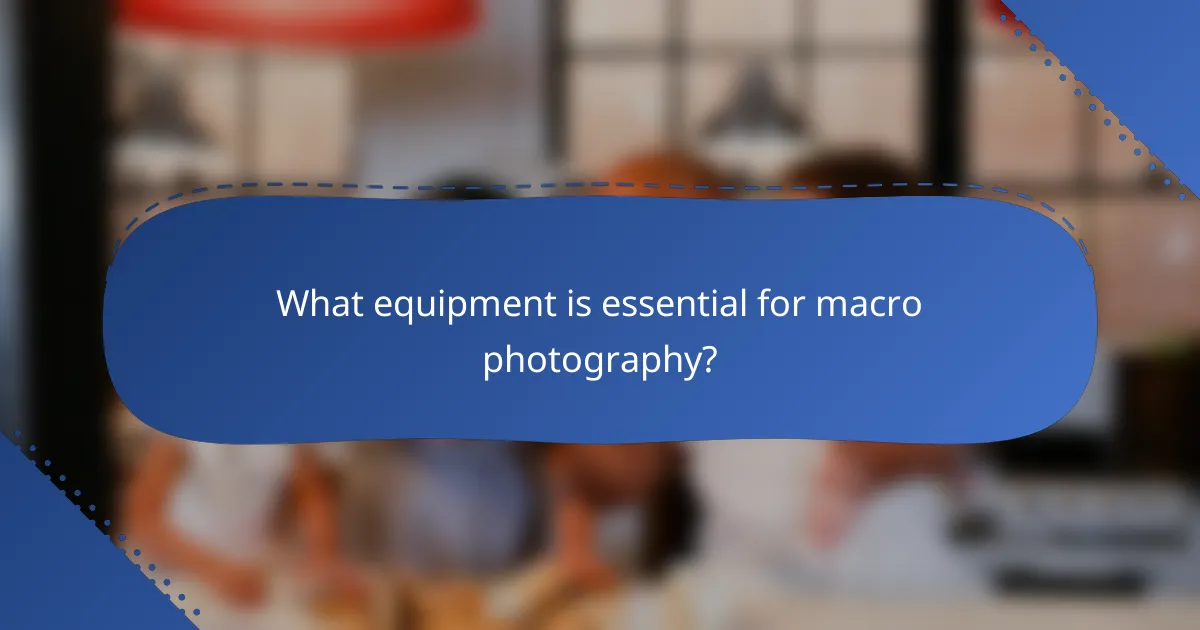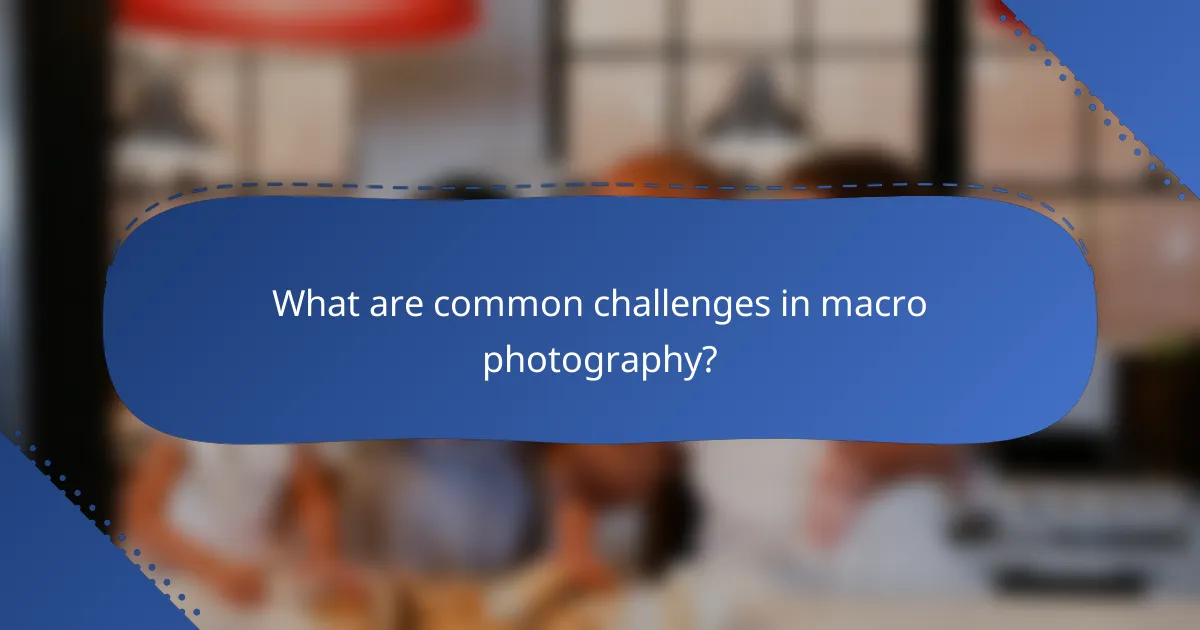Macro photography allows you to explore the intricate details of small subjects, making focus, lighting, and composition essential elements for stunning images. Mastering techniques such as using a tripod and selecting the right aperture can enhance focus, while effective lighting techniques illuminate your subjects beautifully. Additionally, thoughtful composition helps to frame your shots and highlight the fine details that make macro photography so captivating.

How to achieve focus in macro photography?
Achieving focus in macro photography is crucial for capturing intricate details of small subjects. Techniques like using a tripod, selecting the right aperture, and employing manual focus can significantly enhance your results.
Use a tripod for stability
A tripod is essential for macro photography as it stabilizes your camera, reducing the risk of blur from hand movement. Look for a sturdy tripod that can support your camera’s weight and allow for precise adjustments.
Consider using a tripod with a ball head or a geared head for better control over positioning. This stability is especially important when shooting at slow shutter speeds or with narrow apertures.
Select a narrow aperture
Choosing a narrow aperture, such as f/8 to f/16, increases the depth of field, allowing more of your subject to be in focus. This is particularly beneficial in macro photography, where the focus range can be very shallow.
However, be mindful that using a very narrow aperture can lead to diffraction, which may soften the image. Test different settings to find the best balance between sharpness and depth of field.
Utilize focus stacking techniques
Focus stacking involves taking multiple images at different focus points and combining them in post-processing to create a single image with greater depth of field. This technique is useful for subjects that require extensive detail throughout.
To implement focus stacking, capture a series of images while adjusting the focus slightly between each shot. Software like Adobe Photoshop or dedicated focus stacking programs can help merge these images seamlessly.
Employ manual focus
Manual focus allows for precise control over the focus point, which is crucial in macro photography where autofocus may struggle. Use the camera’s live view feature to magnify the subject for accurate focusing.
When using manual focus, take your time to ensure the desired part of the subject is sharp. This technique is particularly effective for static subjects, such as flowers or insects.
Experiment with depth of field
Depth of field (DoF) is the range of distance within a photo that appears sharp. In macro photography, manipulating DoF can create striking images by isolating the subject or providing context.
Experiment with different apertures and focus points to see how they affect the overall composition. A shallow DoF can emphasize details, while a deeper DoF can capture the environment around your subject.

What lighting techniques enhance macro photography?
Effective lighting techniques are crucial for enhancing macro photography, as they help to illuminate small subjects and reveal intricate details. Utilizing natural light, artificial sources like ring lights, and diffusers can significantly improve the quality of your macro images.
Utilize natural light effectively
Natural light can create stunning macro photographs, especially during the golden hours of early morning or late afternoon. Position your subject to take advantage of soft, diffused sunlight, which minimizes harsh shadows and highlights.
Pay attention to the direction of light; backlighting can enhance textures and colors, while side lighting can reveal depth. Consider using reflectors to bounce light onto your subject for a more balanced exposure.
Incorporate ring lights
Ring lights provide even illumination around your lens, reducing shadows and allowing for detailed close-ups. They are particularly useful for capturing small subjects like insects or flowers, where even lighting is essential.
When using a ring light, adjust the brightness to avoid overexposure, especially with reflective surfaces. Many ring lights come with adjustable color temperatures, allowing you to match the light to your environment for consistent results.
Use diffusers for soft light
Diffusers soften harsh light, creating a gentle glow that enhances the details of your subject. You can use commercial diffusers or create your own with materials like white fabric or translucent plastic.
Position the diffuser between the light source and your subject to reduce glare and soften shadows. This technique is particularly effective in bright sunlight, where direct light can be too harsh for macro photography.
Experiment with flash techniques
Using flash can add depth and detail to macro images, especially in low-light conditions. Off-camera flash techniques can help you control the direction and intensity of light, allowing for creative effects.
Consider using multiple flashes or a softbox to diffuse the light further. Be cautious with flash power settings to avoid overexposing your subject, and practice adjusting your settings to find the right balance for your specific scene.

How to compose macro photographs?
Composing macro photographs involves careful consideration of elements like framing, focus, and background to highlight intricate details. Effective composition can significantly enhance the visual impact of your close-up images.
Apply the rule of thirds
The rule of thirds is a fundamental guideline in photography that suggests dividing the frame into a 3×3 grid. Positioning your subject along these lines or at their intersections can create a more balanced and engaging composition.
When composing macro shots, consider placing the focal point of your subject off-center. This approach often leads to a more dynamic image, drawing the viewer’s eye across the photograph.
Focus on the subject’s details
In macro photography, the details of your subject are crucial. Ensure that the most interesting features, such as textures or colors, are in sharp focus to captivate the viewer.
Utilize a shallow depth of field to isolate the subject from the background. This technique can enhance the details and create a pleasing bokeh effect, making the subject stand out even more.
Incorporate leading lines
Leading lines are compositional elements that guide the viewer’s eye toward the main subject. In macro photography, these lines can be found in natural elements like stems, petals, or even the contours of the subject itself.
Look for lines that draw attention to your focal point, enhancing the overall flow of the image. This technique can create a sense of depth and perspective, making the photograph more engaging.
Use negative space strategically
Negative space refers to the area surrounding your subject, which can help emphasize the main focus. Using negative space effectively can create a sense of simplicity and elegance in your macro photographs.
Consider leaving ample space around your subject to allow it to breathe within the frame. This approach can enhance the visual impact and draw the viewer’s attention directly to the details of the subject.

What equipment is essential for macro photography?
Essential equipment for macro photography includes specialized lenses, extension tubes, tripods, and lighting tools. Each of these components plays a crucial role in capturing detailed close-up images of small subjects.
Macro lenses for close-up shots
Macro lenses are specifically designed for close-up photography, allowing you to capture subjects at a 1:1 ratio or greater. These lenses typically have a longer focal length, which helps in achieving sharp focus on tiny details while maintaining a comfortable working distance.
When selecting a macro lens, consider options with focal lengths ranging from 50mm to 200mm. A 100mm lens is often a popular choice, balancing versatility and ease of use for various subjects.
Extension tubes for increased magnification
Extension tubes are hollow tubes that fit between your camera body and lens, increasing the distance between the lens and the sensor. This results in greater magnification, allowing you to focus on smaller subjects that may be difficult to capture otherwise.
Using extension tubes is a cost-effective way to enhance your macro capabilities without investing in additional lenses. They come in various lengths, and using multiple tubes can further increase magnification, but be cautious as this may reduce light entering the camera.
Tripods for stability
Stability is crucial in macro photography due to the shallow depth of field and the potential for camera shake. A sturdy tripod helps maintain focus and composition, especially when shooting at slower shutter speeds.
Look for tripods that are adjustable and can support the weight of your camera and lens setup. A tripod with a ball head or a macro focusing rail can provide additional flexibility for precise adjustments.
Lighting equipment for better visibility
Good lighting is essential for macro photography, as it enhances details and colors in your subjects. Natural light can be effective, but using dedicated lighting equipment, such as ring lights or flash units, can help illuminate your subject evenly.
Consider using diffusers to soften harsh light and reduce shadows. Portable LED lights can also be beneficial for on-the-go shooting, providing consistent illumination without the need for bulky setups.

What are common challenges in macro photography?
Macro photography presents several challenges, primarily related to focus, lighting, and composition. Photographers often struggle with achieving sharp focus on tiny subjects, managing light effectively, and composing images that highlight intricate details.
Focus issues
In macro photography, achieving precise focus is critical due to the shallow depth of field. Even slight movements can result in out-of-focus images, making it essential to use techniques like focus stacking or a tripod to stabilize the camera. Consider using manual focus for better control over the focal point.
Another common issue is the tendency for autofocus systems to struggle with small subjects. When photographing insects or flowers, the autofocus may lock onto the background instead. To mitigate this, pre-focus on a specific area where the subject is likely to appear.
Lighting challenges
Lighting is a significant challenge in macro photography, as small subjects often cast harsh shadows or are difficult to illuminate evenly. Natural light can be unpredictable, so using diffusers or reflectors can help soften shadows and create a more balanced exposure.
Additionally, consider using external flash or LED lights to enhance visibility. When using flash, be cautious of overexposure; a diffuser can help spread the light and prevent harsh highlights on reflective surfaces.
Composition difficulties
Composing macro images requires attention to detail and an understanding of how to frame small subjects effectively. It’s essential to consider the background, as clutter can distract from the main subject. Using a plain or blurred background can help emphasize the details of the subject.
Experimenting with different angles and perspectives can also enhance composition. Shooting from a lower angle or slightly off-center can create more dynamic images. Remember to keep the rule of thirds in mind to create visually appealing compositions.
